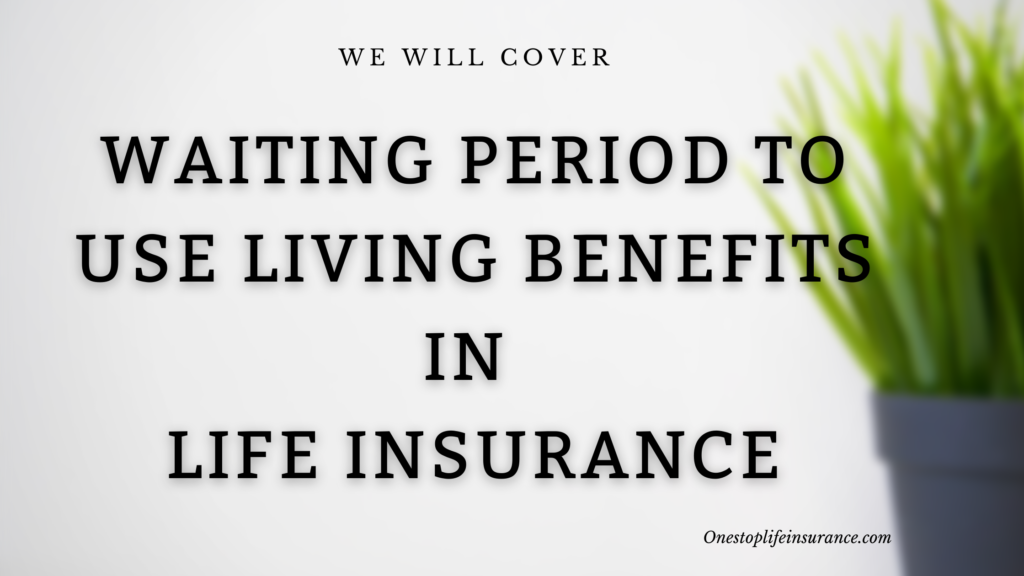Waiting period to use living benefits in life insurance
Accelerated Benefit Riders, also known as living benefits are gaining momentum. More and more companies are acknowledging their value and are offering them to their life insurance products. However, the concept of life insurance with living benefits is still new for many and naturally, there are many questions about it. The question we would focus on is: Is there a waiting period to use living benefits in life insurance.
It is something that many of our clients have asked us and therefore we felt it is important to share some information.

Here are the topics we would cover in this article
What are living benefits in life insurance?
If you have any specific questions or would like us to take a look at your individual situation, simply reach out to us. We would take the time to go over your options and provide you with a personalized solution.
What are living benefits in life insurance?
Prior to diving in, we wanted to advise you that if you have a specific question, not covered in the guide, you can simply reach out to us. We would take the time to listen and provide you with unbiased advice. You can call us, email us, or view your instant quote, using the tool on the page.
We felt it is appropriate to start here and explain what exactly are accelerated benefit riders or living benefits. Essentially, these riders allow the policy owner to access the death benefit, while the insured is still alive. In other words, you don’t have to die for the policy to payout.
To trigger any of the riders, you need to be diagnosed with a qualifying medical condition (we’ve listed more information on that in another article). What we want you to know is that living benefits could be available in a term, as well as in permanent insurance.

Please note that living benefits are not the same as the cash value in a life insurance policy or long-term care insurance. There are several key differences between the products.
Is there a waiting period to use living benefits in life insurance
This is a very common question we receive. The waiting period would mean when would be eligible to file a claim to accelerate the death benefit of a life insurance policy. Typically, living benefits are part of the policy from day 1, however, you would be able to file a claim after 30 days to 90 days after diagnosis.
Below we grouped some of the factors determining eligibility and waiting period:
Under what condition you are accelerating the policy
You can accelerate your policy under a specific eligible condition. Typically the conditions, or triggers, are grouped in 3 separate categories. Each category has a separate waiting period before you are able to file for acceleration:
- Critical – you can file for acceleration under this category, if you have been diagnosed with a critical illness, such as a heart attack, stroke, invasive cancer and etc. The typical waiting period is 30 calendar days.
- Chronic illness – you can file for acceleration under this category, if you are unable to perform at least 2 out of the 6 activities of daily living (bathing, continence, dressing, eating, toileting, transferring) or are diagnosed with cognitive impairment. The typical waiting period is 90 calendar days.
- Terminal illness – you can file to accelerate if you have been diagnosed with a terminal illness and are expected to pass away within 12 or 24 months. There is no waiting period.
State you are located in
Yes, what state you are in makes a difference in the policy provisions. There are several states, with different insurance regulations. Life insurance companies are forced to amend their policies, to comply with the regulations. When it comes to living benefits, California and New York have separate regulations. We’ve outlined some of the basics when it comes to life insurance with living benefits in CA.
On top of that, some states would require you to be diagnosed with a condition for a minimum of 2 years, before you are eligible to file a claim.
For example, if you are living in AZ, DC, ND, SD and are diagnosed with a chronic illness, the waiting period could be 2 years, before you are able to file a claim.
The company you apply with
Please note, the waiting periods listed above are typically industry standards, however, there could be variations amongst the different carriers. It is essential to review your policy and check if there is any additional waiting period. Generally, when you are looking into life insurance with living benefits, the waiting period is very short. However, we strongly urge you to double-check your policy.
Things to remember
We felt it is important to group some of the things you need to keep an eye on:
- Living benefits do not cover pre-existing conditions. In other words, you need to be diagnosed with an illness after the policy effective date
- Commonly, companies apply an actuarial discount when calculating the benefit you can receive.
- Set realistic expectations – living benefits could be extremely helpful if used properly. Keep in mind that they are designed to help you financially, should you be diagnosed with a major health condition.
- Not every company offers the same living benefits – this is key. There are companies that offer all three categories (terminal, critical, and chronic illness), while there are some that offer only one. Make sure you check and ensure your policies include all three. In addition, different companies could have different limits and number of qualifying triggers. We’ve dedicated an article outlining some of the differences when it comes to living benefits in various carriers.
In conclusion,
Living benefits are the modern take on life insurance. They allow you to use your policy, while you are still alive. Usually, there is no waiting period for the benefit to start. However, you need to be diagnosed with the condition for 30 to 90 days before you are eligible to file for an acceleration. If you would like us to review your personal situation and offer a customized plan, simply reach out to us.
We hope you find this helpful and are looking forward to working with you!
Thank you!